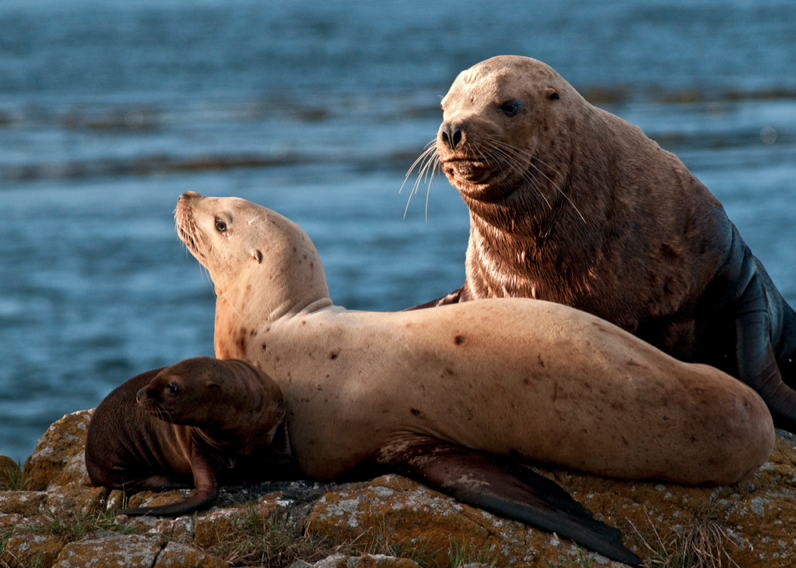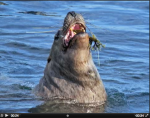ROBIN W. BAIRD1 and M. BRADLEY HANSON2
1) Marine Mammal Research Group, Box 6244, Victoria, British Columbia V8P 5L5 and Biology Department, Dalhousie University, Halifax, Nova Scotia B3H 4J I
2) National Marine Mammal Laboratory, National Marine Fisheries Service, 7600 Sand Point Way N.E., Building 4, Seattle, Washington 98115
*Reviewed and approved by COSEWIC 16 April 1996-status assigned: Not at Risk (NAR).
This report reviews the general biology, status. and management of the Northern Fur Seal (Callorhinus ursinus), with special reference to its status in Canadian waters While Northern Fur Seals do not breed within Canadian waters. They can be found in large numbers in the waters offshore of British Columbia year-round, and occasional stragglers are found inshore. Generally found only in small groups during the pelagic phase of their life, the largest numbers occur in British Columbia waters from January through June. The eastern North Pacific population has declined significantly over the last 30 years, but the cause is unknown.
Baird, Robin W., and M. Bradley Hanson. 1997. Status of the Northern Fur Seal, Callorhinus ursinus. in Canada. Canadian Field-Naturalist 111(2): 263-269.
Key Words: Northern Fur Seal, Callorhinus ursinus, otariid, status, British Columbia
This review of the general biology, status, and management of the Northern Fur Seal, Callorhinus ursinus (Linnaeus 1758), was prepared on behalf of the Committee on the Status of Endangered Wildlife in Canada (COSEWIC). A compilation and assessment of the available information on this species is used to evaluate its status in Canadian waters. For this species such a task is relatively easy in comparison to the many lesser known species of marine mammals in Canadian waters, because of the extensive investigations undertaken by U.S., Russian, and Canadian researchers.
The Northern Fur Seal, a member of the sea lion family (Otariidae), is the second smallest pinniped found on the west coast of Canada. Adult males reach a length of 1.9 m and a weight of about 200 kg, while females are much smaller, reaching a length of 1.3 m and a weight of 35 kg (Figure 1). The pelage of adults is generally a brownish-grey colour. The vibrissae colour varies with age, being black in juveniles and white in fully grown adults.
Distribution
Northern Fur Seals range throughout the northern Pacific from central Japan (latitude 36ºN) and the Sea of Japan north to the Bering Sea, and south along the west coast of North America to the area of the U.S.-Mexican border (latitude 32ºN) [Figure 21. Fur seals can be found throughout this range in almost all months of the year, but peak abundance varies seasonally and geographically. Off the Canadian west coast, females and subadult males are typically found during the winter off the continental shelf (Bigg, 1990). Occasional animals are seen in inshore waters in British Columbia, and stragglers occasionally come ashore, usually at sea lion haulouts (e.g., Race Rocks, off southern Vancouver Island).
Three breeding colonies occur in Russia; at Robben (Tyuleniy) Island and the central Kuril Islands in the Sea of Okhotsk, and Commander Island in the western Bering Sea. In the United States, colonies occur at the Pribilof Islands (St. George and St. Paul islands) in the eastern Bering Sea, at Bogoslof Island in the southeast Bering Sea, and at San Miguel Island and nearby Castle Rock off southern California. Reeves et al. (1992) noted that a few fur seals also haul out seasonally on Southeast Farallon Island and occasionally on San Nicolas Island, off California.
Protection
International
The Interim Convention on Conservation of North Pacific Fur Seals lapsed in 1984, when the United States Senate failed to ratify a protocol for extension. This international agreement protected the fur seal from hunting at sea, but also allowed for the commercial harvest of fur seals in the Pribilof Islands. Attempts to establish a new treaty for the protection of the fur seal have failed; consequently the species is vulnerable to future hunting of animals at sea. Under the terms of this agreement Canada received 15 percent of the skins from harvests, and was also obliged to undertake research on this species.
The Northern Fur Seal is not listed under the Convention on International Trade in Endangered Species of Wild Fauna and Flora (CITES), thus international trade is not monitored or regulated.
National
Canada: In Canada the Northern Fur Seal is protected under the 1993 Marine Mammal Regulations of the Fisheries Act of Canada. These regulations control the hunting of this species in Canadian waters by all except aboriginals, who are required to obtain a licence. Fees for such a licence are low ($5), and issuance is at the discretion of the Minister of Fisheries and Oceans. “Disturbance” is prohibited through these regulations, except when hunting under licence, as is the operation of aircraft within 600 m of any live seal on land.
United States: After the international convention lapsed in 1984, management of this species in U.S. waters became subject to the Fur Seal Act of 1966 and the Marine Mammal Protection Act of 1972. The commercial harvest on the Pribilof Islands ended because the National Marine Fisheries Service (NMFS) determined that such a harvest could not take place under domestic laws. Current levels and conditions for a subsistence harvest are regulated under these Acts. In 1988 the U.S. population was listed as depleted under the Marine Mammal Protection Act. Under this Act, a conservation plan was prepared for this species (National Marine Fisheries Service 1993), outlining protective measures and research activities to be undertaken by the U.S. National Marine Fisheries Service.
Population Size(s) and Trends
Several stocks have been generally recognized for the Northern Fur Seal; however, tag returns suggest that some exchange occurs between breeding colonies. The Pribilof Islands population is the largest, comprising three quarters of the world’s total, with just less than one million individuals in the early 1990s (National Marine Mammal Laboratory, unpublished data). This population was thought to number between two to three million individuals in the mid-1800s (National Marine Fisheries Service 1993), and was estimated at approximately 2.1 million individuals in the 1940s (Kenyon et al. 1954; Lander and Kajimura 1982; Briggs and Fowler 1984). Based on pup counts, the population on St. Paul Island (representing about 80% of the Pribilof stock) has remained relatively stable since the early 1980s, while the St. George stock has undergone a significant decline since the late 1970s (York and Fowler 1992). The Pribilof Island population(s) appear to be well below the level of maximum net productivity (Ragen 1995). Northern Fur Seals first began breeding at Bogoslof Island in the southeast Bering Sea in 1980, and the population in 1988 comprised over 400 individuals, increasing at a rate of 57% per year (Loughlin and Miller 1989). Fur seals also began breeding at San Miguel Island (California) in 1968 and at nearby Castle Rock in 1972. The San Miguel colony numbered approximately 5000 individuals by 1993 and was increasing (DeLong et al. 1993).
Habitat
Terrestrial habitats for Northern Fur Seals are generally limited to their rookeries, which are scattered around the North Pacific rim in close proximity to the continental slope. Fur seals have strong fidelity to traditional sites that are typically composed of a rocky substrate (on San Miguel Island they use a sand beach). Although all rookeries in the U.S. are federally owned, the Pribilof Islands are inhabited and non-rookery lands are owned by local communities which are developing support facilities for fishing industries. Consequently, several types of habitat degradation are possible.
Ocean habitats appear to vary by the sex and age group(s) of fur seals present. In the summer breeding season, continental slope waters in the eastern Bering Sea are the principal destination for adult females on foraging trips. The use of continental shelf and slope waters of British Columbia and the states of Washington, Oregon, and California by adult females during winter is well documented from pelagic sealing data (Bigg 1990). Adult males from the Alaskan populations appear to remain in Alaskan waters year-round, some remaining in the Bering Sea and some moving south into the Gulf of Alaska in mid-winter. Subadults of both sexes use coastal waters of British Columbia and Washington as well as offshore areas of the North Pacific (Kajimura 1984; Bigg, 1990). The highest concentrations in the open ocean occur along the continental shelf break and in association with other major oceanographic frontal features, such as canyons, sea mounts and valleys (Kajimura 1984). Although water quality in these areas is unknown, it appears to be suitable with the exception of areas subjected to oil spills. Trends in the availability of prey in these areas are unknown.
General Biology
Reproduction
Female Northern Fur Seals may produce their first pup at four years of age, and the majority are pupping by six years of age (York and Hartley 1981). A single pup is born within two days of the arrival of a female at the breeding colony. Parturition appears to be stimulated by arrival at the breeding colony and the presence of conspecifics (Bigg 1984). For the first 8-10 days after birth, females remain ashore until they come into estrous and mate. After that time they regularly leave the colony for foraging trips of 4- 10 days. Insley (1992) demonstrated that calls used between mother-offspring pairs of Northern Fur Seats were highly variable between individuals, but varied little for a particular individual, allowing the mother and pup to reunite after separating. Pups remain on the breeding islands until they are weaned in late fall. Pup weight depends in part on that of the mother and on sex, male pups are larger at birth (Bottnev 1993). Adult males remain ashore and fast while defending breeding territories. Juvenile males also haul out during the breeding season and fast, typically losing about 20% of their body mass during this time (Baker et al, 1993).
Figure 1: Northern Fur Seals Photo by O. W. Otsen. The small animal at left is an adult female, the large animal is an adult male.
Diet
Knowledge of the diet of the Northern Fur Seals comes primarily from the examination of stomach contents of animals killed as part of a joint U.S.-Canadian research program from 1958 to 1974 (Kajimura 1984; Perez and Bigg 1986), and in part from scat analysis (Antonelis et al, 1990, 1993). Primary prey species vary seasonally (Perez and Bigg 1986). Differences in diet also occur throughout their range, both on a large (Perez and Bigg 1986) and small scale (Antonelis et al. 1993). Small schooling fishes are the primary food species in terms of energy content. In Biitish Columbia waters, Pacific Herring (Clupea harengus) and various species of squid comprise about 70% of the diet. Walleye pollock, sablefish, rockfishes, whiting, and salmonids form the remainder of the diet (Perez and Bigg 1986). Historical evidence suggests that the composition of the diet has fluctuated over time with changes in fish stocks; sardines were once extremely abundant in the eastern North Pacific but were over-fished in the 1940s until the stocks collapsed. There is some evidence that sardines were commonly eaten by Northern Fur Seals off Vancouver Island in the early 1930s (Clemens and Wilby 1933).
Movements
In general, Pribilof Island fur seals migrate south to winter along the west coast of Canada and the United States. However, patterns of movement of this species are extensive and complex, with timing and migratory routes depending on age, sex and reproductive condition (Bigg 1990). Bigg (1990) suggested that fur seal migration from the Bering Sea after the breeding season facilitated both the avoidance of low temperatures and access to sources of prey. He also suggested that the age-related differences in migratory timing and routes likely results from a combination of the learning of productive foraging areas and the need to return to the breeding areas when animals reach reproductive age. The origin of sex-related differences in migration may result in part from differences in the timing of arrival to and departure from the breeding colonies. Adult females both arrive at and leave colonies later than adult males. Males start to arrive at colonies in May to establish territories and females start arriving in mid-June. Males depart in late summer while females remain until late fall while they continue to nurse their young. The fall movements of pups away from the rookeries is not random; estimated minimum swimming speed of pups between St. Paul Island and the Aleutians was between 36 to 61 km/day (Ragen et al. 1993). Fowler et al. (1993) demonstrated that male Northern Fur Seats generally return to their natal rookery, although individuals sometimes emigrate to other rookeries or, rarely, form new colonies.
Short-distance movements around San Miguel Island by females nursing pups were examined by Antonelis et al, (1990), who found that females foraged primarily in oceanic waters over the continental slope. These females departed the colony in greatest numbers in mid-day, possibly a thermoregulatory behaviour in response to increasing temperatures and solar radiation.
Behaviour
Northern Fur Seals generally exhibit strong site fidelity to their rookeries. Despite disturbance associated with commercial harvesting by human inhabitants on the Pribilof Islands from the late 1700s until recently, seals continue to occupy nearly all the same rookeries. This species appears to be tolerant to short term disturbance associated with human activities (Gentry and Gilman 1990). The proximity of these islands to the continental slope likely contributes to their continued use of these rookeries.
Limiting Factors
Commercial harvesting has affected the population of Northern Fur Seals in the Pribilof Islands since shortly after it was first discovered in 1786 (National Marine Fisheries Service 1993). From 1786 to 1828 an average of a hundred thousand Northern Fur Seals per year, primarily pups, were killed. Commercial harvesting of this species was directly responsible for the large reductions in population size in the late 1800s and early 1900s. The commercial harvest during this early period included pregnant females; during the period of pelagic sealing, large numbers of animals were taken off British Columbia and in the Bering Sea (National Marine Fisheries Service 1993). Hunts were reduced in size in the early 1900s, and the population grew up to the 1940s. Approximately 300 000 females were killed between 1956 and 1968, in an effort to move the population towards the level where productivity would be maximized. The population did not respond as expected however, and pup production decreased (York and Hartley 1981). When the commercial harvest of females ceased in 1968, pup production increased and the population grew until 1976. While hunting continued during this period, it is considered unlikely to be the cause of a decline in the population size after 1976 (National Marine Fisheries Service 1993). Commercial harvests continued for this species up until the expiration of the Interim Convention on Conservation of North Pacific Fur Seals in 1984. Since that time, between about 1200 and 3700 juvenile males have been killed each year as part of a subsistence harvest. Such levels are not thought to contribute to the lack of recovery of the population (National Marine Fisheries Service 1993).
A variety of other natural and anthropogenic sources of mortality for this species have been observed. Several authors have examined causes and levels of mortality in pups, both at breeding colonies and during the winter. Calambokidis and Gentry (1985) observed that pup survival from birth to weaning was positively correlated with birth weight, which in turn was correlated with the age of the mother. Pups which weighed less than average were more likely to die from trauma, parasitic infestation and infectious disease. as well as “emaciation syndrome”. Baker and Fowler (1992) examined pup weight and overwintering survival. and found that the overwintering survival of males increased with pup weight. Their small female sample size likely precluded a similar determination (Baker and Fowler 1992). They suggested that larger overwintering animals were better able to withstand cold temperatures. Larger animals are also able to dive longer (Kooyman 1989 in Baker and Fowler 1992), possibly increasing the ability to find prey. Predation by sharks, foxes, Killer Whales (Orcinus orca) and Steller Sea Lions (Eumetopias jubatus) has been recorded (Bychkov 1967: Gentry and Johnson 1980; Hanna 1922; Reeves et al. 1992; National Marine Fisheries Service 1993). Three to seven percent of fur seal neonates on St. George Island were killed by sea lions in 1974 and 1975 (Gentry and Johnson 1980); no data on mortality levels from Killer Whales or sharks are available.
Natural environmental fluctuations, such as the periodic occurrence of El Niño, has negatively affected the population breeding at San Miguel Island, although conditions for the Pribilof Island population may be enhanced by increased sea surface temperatures associated with these events (York 199 1 ). The 1983 El Niño occurred just prior to implantation of embryos at San Miguel Island, and resulted in an increase in pup mortality and a decrease in pup weights. DeLong et al. (1993) suggested that the later onset of the 1992 El Niño affected this population less intensely. Competition with fisheries has been suggested as a possible limiting factor for this species, both in waters surrounding breeding colonies, along migration routes, and during the non-breeding season in the North Pacific. The interactions between commercial harvesting of prey species and fur seal movements, reproductive rates or mortality is unclear, however (National Marine Fisheries Service 1993).
FIGURE 2. Distribution of the Northern Fur Seal off the west coast of North America.
Breeding islands are located in the circles. Reproduced from Loughlin and Miller (1989) by permission.
Calambokidis and Peard (1982) examined levels of chlorinated hydrocarbons from Northern Fur Seals in Alaska, but found concentrations well below levels thought to contribute to reproductive problems in other populations of pinnipeds. Anas (1974) reported levels of heavy metals in fur seals from Alaska and Washington State, but no information is available on potential impacts. An analysis of heavy metals by Noda et al. (1995) revealed higher cadmium concentrations in northern fur seals than in other otariids. Cadmium levels were higher, and mercury levels lower, than those reported by Anas (1974); however, heavy metal concentrations in Northern Fur Seals are variable with age, location, and probably season, making comparisons between studies difficult (Noda et al. 1995). Entanglement in fishing gear is probably a more significant problem. Northern Fur Seals were the third most commonly caught species of marine mammal recorded in an observer program of the Japanese driftnet fishery for squid in 1989 (Anonymous 1990). Two animals were killed in an experiment drift gillnet fishery for Neon Flying Squid (Ommastrephes bartrami) in Canadian waters in the mid-1980s (Jamieson and Heritage 1988). Entanglement in marine debris is also a source of mortality. Fowler (1987) suggested that mortality due to entanglement in marine debris has contributed significantly to the decline in the population on the Pribilof Islands. Recent declines have also occurred in the numbers of Steller Sea Lions (Loughlin et al. 1992) and Harbour Seals, Phoca vitulina (Pitcher 1990) in the central and eastern Gulf of Alaska. While many possible causes have been identified (reviewed above), the exact causes of these declines continues to remain unclear.
Special Significance of the Species
This species is the only fur seal found in the temperate waters of the north Pacific Ocean and is endemic to this region. Alaskan natives on the Pribilof Islands harvest approximately 2000 subadult males annually for food.
Evaluation
The present world population of Northern Fur Seals is substantially lower than historical levels,and causes of the decline are unclear. Although the market demand for furs is currently low, the lack of any international regulatory body or agreement on the management of the species means that killing of this species at sea could be undertaken at any time, and trade is not restricted or monitored through any international agency. Rapid development of fishing industry support services on the Pribilof Islands has the potential to adversely affect this population.
Acknowledgments
We thank the Canadian Wildlife Federation for financial assistance for the preparation of this report, Robert Campbell and COSEWIC for providing assistance and support, and several anonymous reviewers for helpful comments on the manuscript.
Literature and Documents Cited
Anas, R. E. 1974. Heavy metals in the northern fur seal, Callorhinus ursinus, and harbor seal. Phoca vitutina richardi. Fishery Bulletin, U.S. 72: 133-137.
Anonymous. 1990. Final report of squid and bycatch observations in the Japanese driftnet fishery for neon flying squid (Onimastrephes bartrami). Joint Report of Fisheries Agency of Japan. Canadian Department of Fisheries and Oceans, United States National Marine Fisheries Service and United States Fish and Wildlife Service.
Antonelis, G. A., B. S. Stewart, and W. F. Perryman. 1990. Foraging characteristics of female northern fur seals (Callorhinus ursinus) and California sea lions (Zalophus californianus). Canadian Journal of Zoology 68:150-158.
Antonelis, G. A., E. H. Sinclair, R. R. Ream, and B. W. Robson. 1993. Inter-island variation in the diet of female northern fur seals (Callorhinus ursinus) in the Bering Sea. Page 23 in Abstracts of the Tenth Biennial Conference on the Biology of Marine Mammals, November 11-15, 1993. Galveston, Texas.
Baker, J. D., and C. W. Fowler. 1992. Pup weight and survival of northern fur seals Callorhinus ursinus. Journal of Zoology, London 227: 231-238.
Baker, J. D., C. W. Fowler, and G. A. Antenelis. 1993. Mass change in fasting immature male northern fur seals. Page 25 in Abstracts of the Tenth Biennial Conference on the Biology of Marine Mammals, November I 1- 15, 1993. Galveston, Texas.
Bigg, M. A. 1984. Stimuli for parturition in northern fur seals (Callorhinus ursinus). Journal of Mammalogy 65: 333-336.
Bigg, M. A. 1990. Migration of northern fur seals (Callorhinus ursinus) off western North America. Canadian Technical Report of Fisheries and Aquatic Sciences 1764.
Boltnev, A. 1. 1993. Pre-natal investment in reproduction and age composition of northern fur seal (Callorhinus ursinus) females on Bering Island, Russia. Page 29 in Abstracts of the Tenth Biennial Conference on the Biology of Marine Mammals, November 11-15, 1993. Galveston, Texas.
Briggs, L., and C. W. Fowler. 1984. Tables and figures of the basic population data for northern fur seals of the Pribilof Islands. In Background papers submitted by the United States to the 27th annual meeting of the Standing Scientific Committee of the North Pacific Fur Seal Commission. March 29-April 9. 1994, Moscow. U.S.S.R. Available from National Marine Mammal Laboratory, Seattle.
Bychkov, V. A. 1967. On killer whale attacks on fur seals off Tyuleniy Island. Zoological Zhurnal 46: 149-150.
Calambokidis, J., and R. L. Gentry. 1985. Mortality of northern fur seal pups in relation to growth and birth weights. Journal of Wildlife Diseases 21(3): 327-330.
Calambolkidis, J., and J. Peard. 1982. Chlorinated hydrocarbons in the tissues of northern fur seals from St Paul Island. Alaska. Final report to Nationai Marine Mammal Laboratory, Seattle.
Clemens, W. A., and G. V. Wilby. 1933. Food of the fur seal off the coast of British Columbia. Journal of Mammalogy 14: 43-46.
DeLong, R. L., S. R. Melin, and G. A. Antonelis. 1993. Comparison of 1983 and 1992 El Niño impacts on California sea lion and northern fur seal populations in California. Page 41 in Abstracts of the Tenth Biennial Conference on the Biology of Marine Mammals, November 11 – 15, 1993. Galveston, Texas.
Fowler, C. W. 1987. Marine debris and northern fur seals: a case study. Marine Pollution Bulletin 18: 326-335.
Fowler, C. W., J. D. Baker, G. A. Antonelis, and A. E. York. 1993. Homing behavior in sub-adult male northem fur seals. Page 49 in Abstracts of the Tenth Biennial Conference on the Biology of Marine Mammals, November I 1- 15, 1993. Galveston, Texas.
Gentry, R. L., and J. H. Johnson. 1980. Predation by sea lions on northern fur seal neonates. Mammalia 45: 423-430.
Gentry, R. L., and J. F. Gilman. 1990. Responses of northern fur seals to quarrying operations. Marine Mammal Science 6: 151-155.
Hanna, G. D. 1922. What becomes of the fur seals Science 60: 505-507.
Insley, S. J. 1992. Mother-offspring separation and acoustic stereotypy: a comparison of call morphology in two species of pinnipeds. Behaviour 120: 103-122.
Jamieson, G. S., and G. D. Heritage. 1988. Experimental flying squid fishery off British Columbia, 1987. Canadian Industry Report of Fisheries and Aquatic Sciences Number 186.
Kajimura, H. 1984. Opportunistic feeding of the northern fur seal, Callorhinus ursinus, in the eastern North Pacific Ocean and eastern Bering Sea. NOAA Technical Report NMFS SSRF-779.
Kenyon, K. W., V. B. Scheffer, and D. G. Chapman. 1954. A population study of the Alaska fur seal herd. U.S. Fish and Wildlife Service. Special Scientific Report on Wildlife. 12. 77 pages.
Lander, R. H., and I-L Kajimura. 1982. Status of northern fur seals. In mammals in the seas. 4, FAO Fish Service 5, Volume 4: 319-345.
Loughlin, T. R., and R. V. Miller. 1989. Growth of the northern fur seal colony on Bogoslof Island, Alaska. Arctic 42: 368-372.
Loughlin, T. R., A. S. Perlov, and V. A. Vladimirov. 1992. Range-wide surveys and estimation of total number of Steller sea lions in 1989. Marine Mammal Science 8(3): 220-239.
National Marine Fisheries Service. 1993. Final Conservation Plan for the northern fur seat (Callorhinus ursinus). Prepared by the National Marine Mammal Laboratory/Alaska Fisheries Science Center, Seattle, Washington, and the Office of Protected Resources/ National Marine Fisheries Service, Silver Spring, Maryland.
Noda, K., H. Ichlbashi, T. R. Loughlin, N. Baba, M. Kiyota, and R. Tatsukawa. 1995. Distribution of heavy metals in muscle, liver and kidney of northern fur seal (Callorhinus ursinus) caught off Sanriku, Japan and from the Pribilof Islands, Alaska. Environmental Pollution 90(l): 51-59.
Perez, M. A., and M. A. Bigg. 1986. Diet of northern fur seals. Callorhinus ursinus, off western North America. Fishery Bulletin, U.S. 84: 957-97 1.
Pitcher, K. W. 1990. Major decline in number of harbor seals, Phoca vilulina richardsi, on Tugiduk Island, Gulf of Alaska. Marine Mammal Science 6(2): 121-134.
Ragen, T. J. 1995. Maximum net productivity level estimation for the northern fur seal (Callorhinus ursinus) population of St. Paul Island, Alaska. Marine Mammal Science 11(3): 275-300.
Ragen, T. J., G. A. Antonelis, and M. Kiyota. 1993. Early phase of northern fur seal (Callorhinus ursinus) pup migration from St. Paul Island. Alaska. Page 88 in Abstracts of the Tenth Biennial Conference on the Biology of Marine Mammals, November 11-15, 1993. Galveston, Texas.
Reeves, R. R., B. S. Stewart, and S. Leatherwood. 1992. The Sierra Club handbook of seals and sirenians. Sierra Club Books, San Francisco.
York, A. E. 1991. Sea surface temperatures and their relationship to the survival of juvenile male northern fur seals from the Pribilof Islands. Pages 94-106 in Pinnipeds and El Niño: responses to environmental stress. Edited by F. Trillmich and K. A. Ono. Springer-Verlag, Berlin.
York, A. E., and J. R. Hartley. 1981. Pup production following harvest of female northern fur seals. Canadian Journal of Fisheries and Aquatic Sciences 38(l): 84-90.
York, A. E., and C. W. Fowler. 1992. Population assessment, Pribilof Islands, Alaska. Pages 9-26 in Fur seal investigations, 1990. Edited by H. Kajimura, and E. Sinclair. U.S. Deptartment of Commerce NOAA Technical Memo. NMFS-AFSC-2.
Accepted 8 July 1996
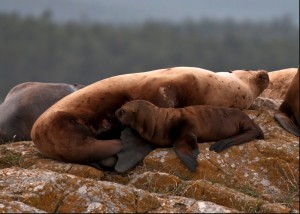 n the fall of 2011, a female northern sea lion (Steller) and her pup appeared at Race Rocks. This is the first such pair that we have seen there. Link to Ryan Muphy’s Flickr site for a set of pictures of the sealions at Race Rocks.
n the fall of 2011, a female northern sea lion (Steller) and her pup appeared at Race Rocks. This is the first such pair that we have seen there. Link to Ryan Muphy’s Flickr site for a set of pictures of the sealions at Race Rocks. 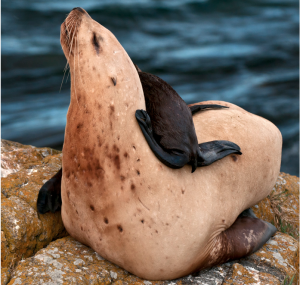 Ryan captured some excellent pictures but noted that due to blasting by the DND on the neighbouring Bentinck Island, the pup was injured and the mother disappeared. See below.. Commentary here is by Ryan Murphy : “Steller or Northern sea lions (Eumetopias jubatus) are the largest sea lion species in the world and are listed under Canada’s SARA (Species at Risk Act) as Special Concern.”
Ryan captured some excellent pictures but noted that due to blasting by the DND on the neighbouring Bentinck Island, the pup was injured and the mother disappeared. See below.. Commentary here is by Ryan Murphy : “Steller or Northern sea lions (Eumetopias jubatus) are the largest sea lion species in the world and are listed under Canada’s SARA (Species at Risk Act) as Special Concern.” 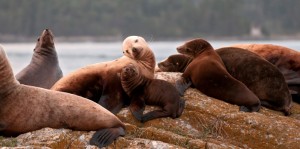 “The Race Rocks archipelago south of Vancouver Island has long been a haul out for Steller sea lions, and we know from Lightkeeper Kurt Cehak’s accounts from the 60s that these marine mammals came to Race Rocks even when locals were encouraged to kill them to collect bounties. “
“The Race Rocks archipelago south of Vancouver Island has long been a haul out for Steller sea lions, and we know from Lightkeeper Kurt Cehak’s accounts from the 60s that these marine mammals came to Race Rocks even when locals were encouraged to kill them to collect bounties. “ 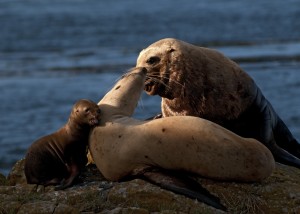 “Today, Steller sea lions are a year-round attraction for a multi-million dollar ecotour industry based in the Capital Region District of Victoria, BC. With the arrival of this pup and its mother to Race Rocks, the Ecological Reserve now protects the reproductive ecology of this threatened species.”
“Today, Steller sea lions are a year-round attraction for a multi-million dollar ecotour industry based in the Capital Region District of Victoria, BC. With the arrival of this pup and its mother to Race Rocks, the Ecological Reserve now protects the reproductive ecology of this threatened species.” 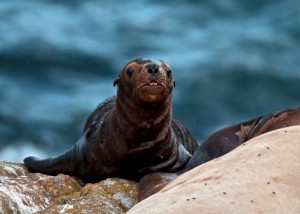 “However, this pup is at risk because of activities of the Canadian Department of National Defence. The island in the background is Bentinck Island and it is used by the Canadian military to dispose of ordinances and explosives training. Their rapid succession blasting during the last two days has caused
“However, this pup is at risk because of activities of the Canadian Department of National Defence. The island in the background is Bentinck Island and it is used by the Canadian military to dispose of ordinances and explosives training. Their rapid succession blasting during the last two days has caused 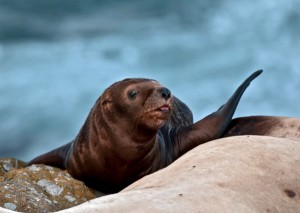 repeated stampedes of sea lions and this pup may be crushed tomorrow.” See the logs on this website posted by the ecoguardians which include mammal census and observations of sealions. Northern Sea lion VIDEOS:
repeated stampedes of sea lions and this pup may be crushed tomorrow.” See the logs on this website posted by the ecoguardians which include mammal census and observations of sealions. Northern Sea lion VIDEOS:

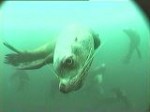
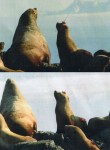
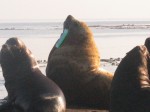
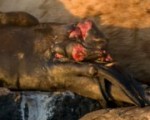

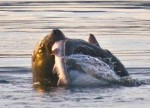
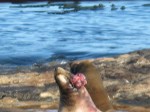
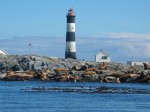
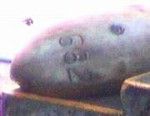
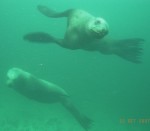
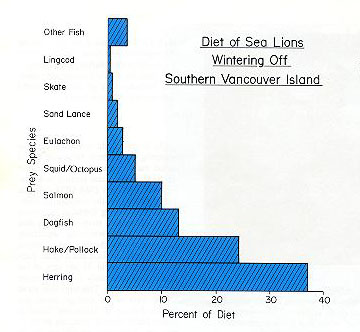 Steller sea lions are marine carnivores. They feed on wild fish (salmon, herring, rockfish, flounder, and Pollock) as well as on invertebrates such as squid and octopus. The Steller sea lions feed at night, usually about 15-20 km. from shore. This relatively selective diet is one of the causes of the sea lions’ decreasing numbers since they compete with humans for this food.
Steller sea lions are marine carnivores. They feed on wild fish (salmon, herring, rockfish, flounder, and Pollock) as well as on invertebrates such as squid and octopus. The Steller sea lions feed at night, usually about 15-20 km. from shore. This relatively selective diet is one of the causes of the sea lions’ decreasing numbers since they compete with humans for this food. The Race Rocks taxonomy is a collaborative venture originally started with the Biology and Environmental Systems students of Lester Pearson College UWC. It now also has contributions added by Faculty, Staff, Volunteers and Observers on the remote control webcams.
The Race Rocks taxonomy is a collaborative venture originally started with the Biology and Environmental Systems students of Lester Pearson College UWC. It now also has contributions added by Faculty, Staff, Volunteers and Observers on the remote control webcams.
